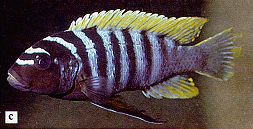

Maylandia sandaracinos, photographed underwater at Nkudzi Bay (the type locality of the species) in the southeast arm of Lake Malawi. The Nkudzi population was previously considered to belong to Pseudotropheus zebra.
Stauffer et al. (1997) distinguish M. sandaracinos from two other species having a blue ground color, black vertical bars, and a red dorsal fin. In M. pyrsonotos the black vertical bars extend distinctly into the basal portion of the dorsal fin. Telling M. sandaracinos from M. emmiltos, however, is not so easy. Stauffer et al. (1997) distinguish M. sandaracinos from M. emmiltos by two breathtakingly trivial "differences." One is the number of teeth in the left lower jaw [a mode of 10-12 in sandaracinos (range 7-13!) versus a mode of 9 in emmiltos (range 8-12!)]. The other is snout length [a mean of 34.4-34.6% of head length (range 30.8-37.8%) in sandaracinos versus a mean ("mode") of 32.9% (range 29.1-35.2%) in emmiltos). Both of these tiny mean or modal differences could easily be geographic, or due to measurement error, or caused by allometry. (Of course, these species may indeed be distinct nevertheless.)
Stauffer et al. also named a fourth "red top zebra" species, Maylandia thapsinogen, which differs from the above three forms in having a yellow gular area (chin, in plain English).
Photo from Plate 1c of
Ribbink et al., 1983;
reproduced by permission of the
Zoological Society of Southern Africa.

| Last Update: 1 June 2008
Web Author: M. K. Oliver, Ph.D. Copyright © 1997-2021 by M. K. Oliver, Ph.D. - ALL RIGHTS RESERVED |